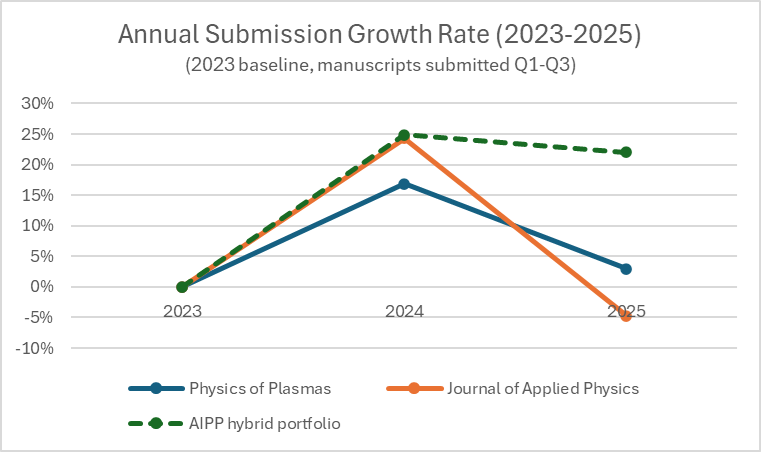by Dean Sanderson, Chief Strategy Officer, and Sara Girard, Head of Marketing and Communications
At AIP Publishing, our mission is to advance the physical sciences through the widest possible dissemination of research. In service of that mission, we continue to evaluate and refine our approaches to open access (OA) publishing, guided by our commitment to transparency, sustainability, and equity for authors, libraries, and readers.
After careful review, AIP Publishing has decided to conclude its Subscribe to Open (S2O) pilot at the end of 2025. The pilot, which applied to the Journal of Applied Physics (JAP) and Physics of Plasmas (POP), provided valuable insights into the potential of the S2O model. However, as our open access portfolio and institutional programs have evolved, it has become clear that maintaining multiple overlapping models introduces unnecessary complexity for authors and librarians alike.
This decision marks a natural evolution in AIP Publishing’s OA strategy — one that moves toward a simpler, more unified approach.
What We Learned from S2O
Launched as a limited pilot, AIP Publishing’s S2O initiative tested whether collective library support could sustain open access publishing for two of our established hybrid journals. Under the S2O model, libraries continued to subscribe as usual, and if enough renewals were secured, that year’s content was made openly available to all.
The results were instructive. Submissions increased modestly following the introduction of S2O, signaling that authors valued the opportunity for open dissemination. Both Journal of Applied Physics and Physics of Plasmas saw measurable growth in manuscript inflows during 2024 compared to 2023, but submission growth trends slowed in 2025 compared to the whole of the AIPP journal portfolio.

Usage also rose. Open access articles published under S2O received higher readership, with 2024 and 2025 content outperforming 2023 volumes. However, this growth was broadly consistent with patterns across AIPP’s hybrid portfolio, rather than a distinctive surge unique to S2O titles.
Financially, the journals met their revenue target thresholds for both 2024 and 2025, but there were a few institutions who canceled their subscriptions. While S2O offered a level of stability, it did not provide a path for scaling or monetizing the journals’ steady expansion. With operational costs increasing, this balance was not sustainable for the long term.
AIPP’s S2O pilot showed that collective support for open access can maintain a journal’s performance, but it did not provide a mechanism for meaningful growth in submissions, usage, or revenue. As a result, AIP Publishing determined that continuing S2O was not the most sustainable or effective way to serve our community, particularly alongside newer, more flexible models.
A Simplified Path Forward
Starting in 2026, Journal of Applied Physics and Physics of Plasmas will move from the S2O pilot into AIP Publishing’s broader open access framework.
This transition is about reducing complexity. Over time, running multiple models — S2O, Read and Publish, and now AIP Fusion — can create confusion and added administrative burden for both libraries and authors. By focusing on models that can apply across our full portfolio, we can make participation simpler, clearer, and more sustainable.
Authors will still have a range of open access publishing options, including Author Select and through institutional agreements under AIP Fusion or Read and Publish (RAP). These programs ensure that publishing open access remains easy and flexible, regardless of funding source or institutional affiliation.
AIP Fusion brings together what worked best under S2O — collaboration, accessibility, and community partnership — but within a unified structure that supports every AIPP and publishing partner title. It provides one clear model for libraries and authors, helping us expand open access across the entire portfolio while maintaining long-term stability.
A Commitment to Progress and Partnership
The decision to conclude the S2O pilot reflects not a retreat from open access, but a commitment to evolving it. By consolidating around fewer, portfolio-wide institutional models, AIP Publishing can deliver greater clarity, scalability, and equity for all participants in the research ecosystem.
To learn more about AIP Publishing’s open access programs, including AIP Fusion, please visit our Open Science page or contact your institutional representative. Together, we are building a more accessible, connected, and sustainable future for physics research.
